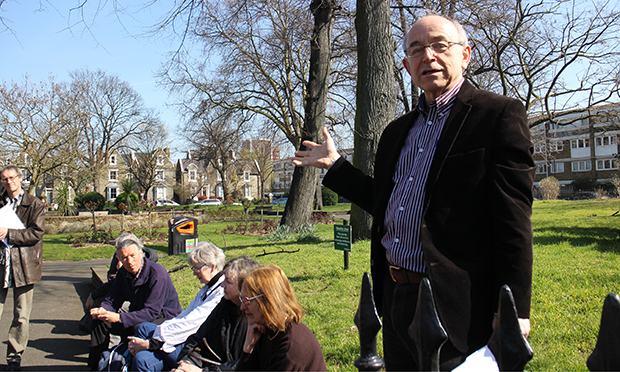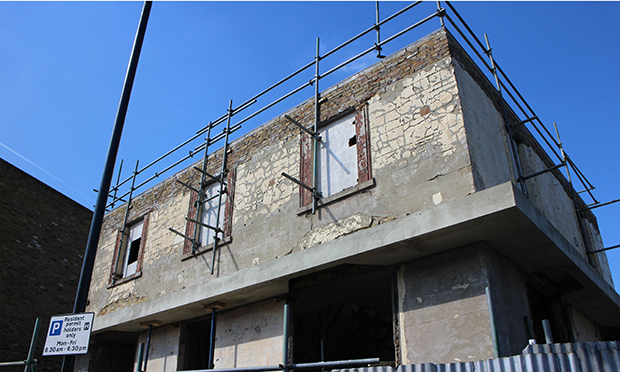Walk this way – history buffs take a tour of De Beauvoir

Grand tour: historian Paul Bolding holds court in De Beauvoir Square
On the first crisp Saturday morning of April, friends and members of the Hackney Society gathered in the sun beside De Beauvoir Square ready to explore the area’s history.
Birds chirped in the blossoming trees as local history enthusiast Paul Bolding explained the early history of the 140 acre estate.
De Beauvoir was created as a result of a legal battle that lasted over ten years between William Rhodes and the Benyon family, who still own the estate.
Before the death of the heirless Reverend Peter De Beauvoir in 1821, William Rhodes had been awarded a building lease on the land. But Richard Benyon contested this.
The House of Lords agreed with the Benyons and construction of three sides of De Beauvoir Square was completed in 1839.
Yet the grandeur of the Benyon’s buildings was to be the area’s downfall, and from the 1840s the area began to decline.
The vast buildings attracted groups of artisans, rather than single families, as the Benyons had intended. Subsequently the upper classes for whom the area was designed were put off moving there.
“In the notebooks of the Victorian social reformer Charles Booth, De Beauvoir Square is described as being a resort of prostitutes,” explained Mr Bolding.
From the Jacobean-styled finery of De Beauvoir Square, the group skipped through the centuries to stand opposite the minimalist ‘Ed’s Shed’.
Officially called the Sunken House, the building, designed by architect David Adjaye, was completed in 2007 for photographer Ed Reeve to act as “architectural punctuation” – the full-stop at the end of a terrace.

Tunnel vision: house of William Lyttle, known as the Hackney ‘Mole Man’
And just as Ed’s Shed stands proud among the pristine stuccoed houses of Northchurch Road, so too does the crumbling shell of Mole Man’s House.
In 2006 the house’s former resident, William Lyttle, was evicted after it was discovered he had dug a warren of tunnels underneath the property that extended for metres under the surrounding streets.
Yet the structure stands preserved as a reminder of its layered history.
From there Bolding led the group into the heart of the Kingsland Basin. Concealed from the outside by towering apartment blocks, Regent’s Canal emerged glistening in the sunlight.
Naomi Lee, an architecture student, said: “I didn’t even know this strange little pocket was here, it’s amazing. And where it is, it’s like the two faces of the De Beauvoir Estate, old and new.”
The industrial past of the Kingsland wharves has long been forgotten, as fellow Hackney Society member Sean Gubbins explained: “The canal used to transport timber from the port, but industry has been replaced with residents. Some people call it the Haggerston Riveria now.
But when the De Beauvoir Association first started to protect this area in the 1970s, there was a lot of industry here.”
The De Beauvoir Association was formed after hundreds of Victorian houses were demolished to make way for the De Beauvoir Estate in 1968 with the aim of protecting the area from further demolition and providing decent housing for working class people.
The group meandered through the estate, which is built on the site of an asylum, to their final destination opposite Tesco Express on Southgate Road.
Shoppers looked on bemused as Bolding explained: “Until 1934 this was the site of the Brotherhood Chapel and in 1907 Lenin, Stalin and Trotsky met here during their exile.”
As a member of the group volunteered to talk more about Lenin’s stay in London, Ray Blackburn, a trustee of the Hackney Society concluded the tour: “We’re lucky because we get a lot of enthusiastic people on these walks.
“As a group we like to preserve the best of what’s been done in the past and encourage the good design for the new development of new buildings.”
hackneysociety.org
